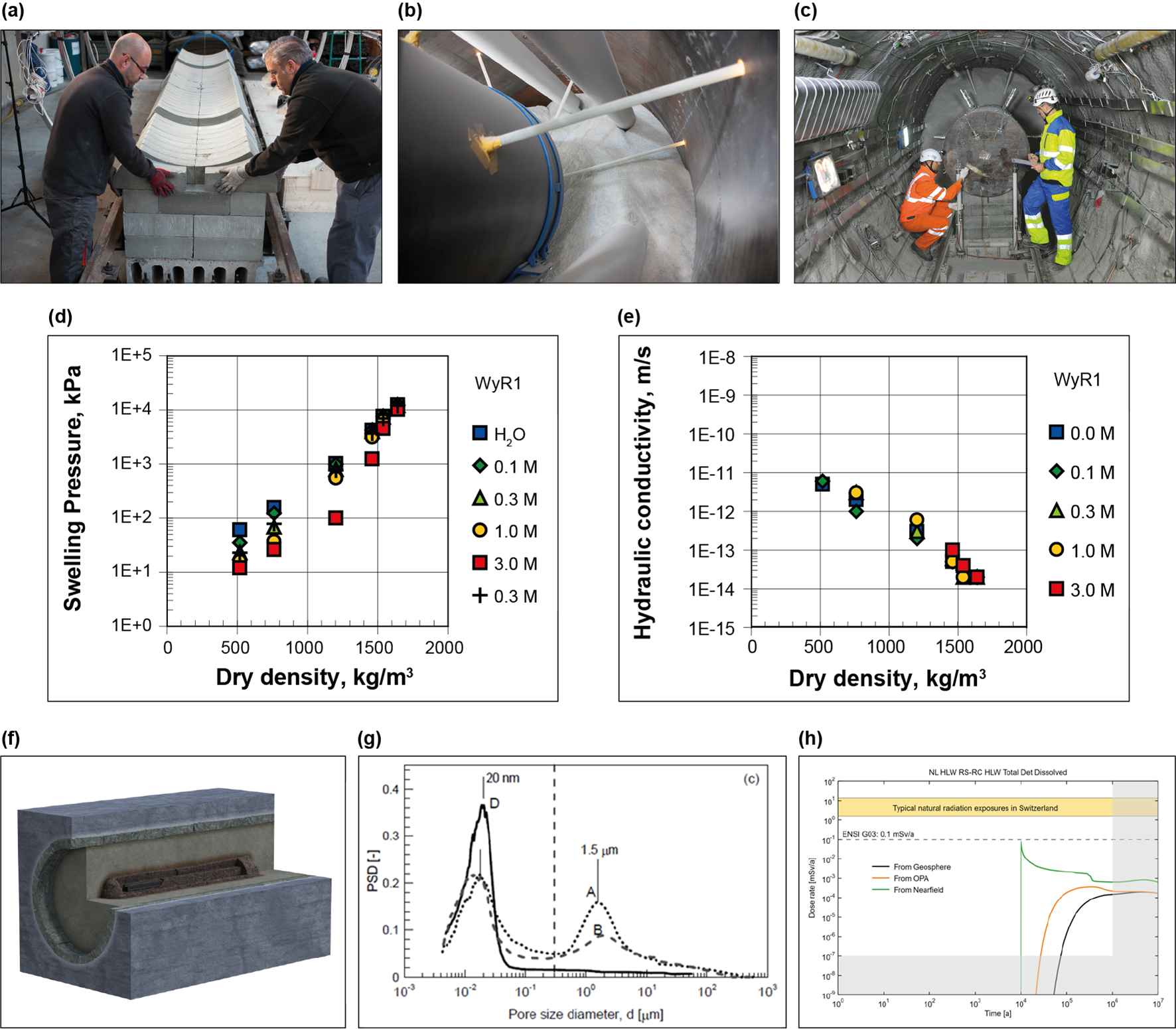The properties of the bentonite buffer (Fig. 6‑5) have been extensively investigated (e.g., Nagra 2019, Leupin et al. 2014, Seiphoori 2015), resulting in a large body of evidence supporting safety-related claims. In particular, the following contribute directly or indirectly to the efficient retention of any radionuclides released following canister breaching:
-
the inherently low hydraulic conductivity of the buffer at full saturation,
-
its self-sealing ability,
-
its marked sorption capacity,
-
the micro-porous environment that it provides at full saturation, and
-
its ability to transport gas without fracturing.

Fig. 6‑5:Bentonite buffer, which has been extensively investigated in small- and large-scale experiments over the last few decades
The handling and emplacement of the bentonite buffer have been successfully demonstrated at a large scale (a-c). It has been shown that the hydraulic properties and the swelling pressure are related to the emplaced dry density (x-axis of (d) and (e); Karnland et al. 2006) and that these properties are not significantly affected by the expected thermohydraulic evolution of the near field (Leupin et al. 2014). The interfaces with the canister and with the cementitious rock support (lining) evolve very slowly as these processes are limited by diffusion (f). The evolving interfaces do not impair the functionality of the bentonite buffer or of the host rock. Upon saturation the pore-size distribution is shifted due to the swelling processes towards nanopores (g) (Seiphoori et al. 2014), a key process defining macro properties such as hydraulic conductivity. The excellent retention properties of bentonite are an important contributor to limiting the radionuclide flux into the host rock (h).
The bentonite buffer has also been shown to provide favourable environmental conditions contributing to the longevity of the HLW canisters by providing a long-lasting, mechanically homogeneous, and chemically favourable interface. The microporous environment within the buffer provides sufficient limitation of microbial activity, and the buffer conducts heat sufficiently well. The waste package, canister, and buffer thus do not experience conditions detrimental to the performance of their safety functions (Nagra 2019).
The geomechanical and the chemical evolution of the cementitious lining around the HLW emplacement drifts do not significantly impair the functionality of any engineered and geological barriers. Specifically, the loss of strength of the lining does not significantly affect the safety functions of the buffer or the intended lifetime of the canister and does not significantly affect the extent and hydraulic properties of the EDZ (Geomechanica Inc. 2025). Indeed, experimental evidence shows that chemical interactions of the lining with the bentonite buffer are spatially limited and thus do not significantly affect the safety functions of the buffer EDZ (Geomechanica Inc. 2025). Indeed, experimental evidence shows that chemical interactions of the lining with the bentonite buffer are spatially limited and thus do not significantly affect the safety functions of the buffer (Chapter 3 in NAB 22-34, Prasianakis et al. 2022 and Yokoyama et al. 2021). These findings are supported by reactive transport modelling (Section 6.7.2 in NTB 23-02 Rev.1, Nagra 2024v, for details about the models see NAB 23-33, Kosakowski 2023).

